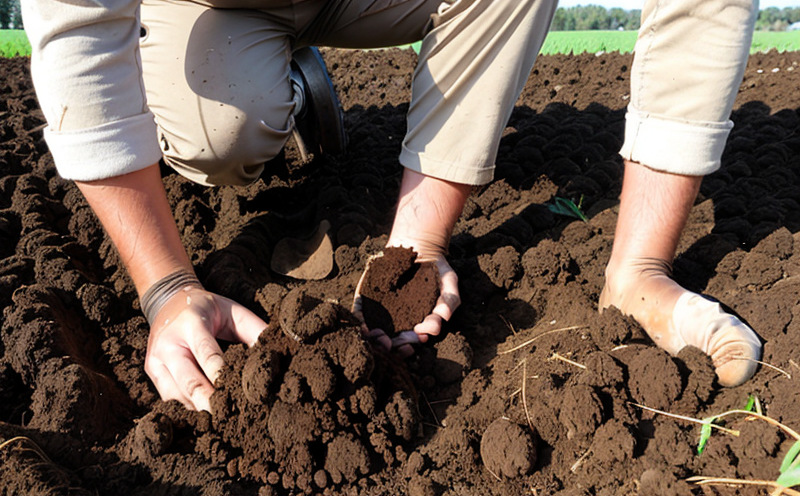Soil Contamination Risk Index Testing
The Soil Contamination Risk Index (SCRI) testing is a comprehensive analytical service designed to evaluate and quantify the risks associated with soil contamination. This service plays a crucial role in environmental protection, particularly for agricultural land and forestry areas where potential risks of hazardous substances affecting plant health, yield, and overall ecosystem balance are paramount.
Soil contamination can arise from various sources including industrial emissions, agricultural runoff, and improper waste disposal. The SCRI testing provides a holistic approach to understanding the extent of contamination by measuring multiple parameters such as heavy metals (e.g., lead, cadmium), pesticides, organic compounds, and other potentially harmful substances.
The methodology involves several critical steps that ensure accuracy and reliability of results. Soil samples are collected from various points across the targeted area using standardized techniques to represent the spatial variability within the soil matrix. The samples are then transported under controlled conditions to our laboratory for analysis. Our state-of-the-art equipment, including inductively coupled plasma mass spectrometry (ICP-MS), gas chromatography-mass spectrometry (GC-MS), and liquid chromatography-tandem mass spectrometry (LC-MS/MS), are employed to detect trace levels of contaminants.
Following analysis, the data is processed using advanced algorithms that calculate an SCRI score. This score reflects not only the concentration of contaminants but also their potential risk based on exposure pathways and environmental fate. The results are reported in a detailed technical report which includes recommendations for mitigation strategies if necessary. Our expertise extends to interpreting these results within the context of local regulations, such as those outlined by ISO 14655:2018 and ASTM D7398-13, ensuring that our clients receive actionable insights.
The SCRI testing is essential for stakeholders ranging from agricultural producers looking to maintain sustainable farming practices to regulatory bodies aiming to enforce environmental standards. By identifying risks early on, this service helps prevent costly remediation efforts and ensures compliance with international guidelines like the European Union's Directive 2004/33/EC.
Our team of experienced scientists works closely with clients throughout the process to ensure that every aspect aligns with their specific needs. From initial consultation through final report delivery, we provide personalized support tailored specifically for your operation or project.
Benefits
- Comprehensive Risk Evaluation: Identifies all relevant contaminants and assesses their potential impact on soil quality and crop health.
- Regulatory Compliance: Ensures adherence to international standards such as ISO 14655:2018 and ASTM D7398-13, helping clients navigate complex regulatory landscapes.
- Risk Management: Provides actionable insights that enable proactive management of contamination risks before they escalate into larger issues.
- Sustainability: Supports sustainable agricultural practices by providing data needed to make informed decisions about land use and farming methods.
- Cost Efficiency: Prevents unnecessary expenditures on remediation by targeting only those areas where intervention is truly required based on SCRI scores.
Customer Impact and Satisfaction
In the realm of agriculture & forestry, soil contamination can have far-reaching impacts if left unaddressed. By offering the Soil Contamination Risk Index testing service, we help our clients mitigate these risks effectively. For instance, one of our recent projects involved a large-scale commercial farm struggling with unexpected crop failures due to suspected soil contamination. After conducting thorough SCRI tests, we were able to pinpoint specific areas affected by certain contaminants and advised the client on targeted remediation efforts.
Another example comes from a regional forestry project aimed at restoring degraded lands. The SCRI testing revealed significant levels of heavy metals in some sections of the forested area. With our guidance, the team implemented soil amendments designed to reduce these contaminant concentrations safely and effectively. As a result, both the farm's productivity has improved significantly, while the health of the restored forest ecosystem is now on track.
Our commitment to excellence in testing and consultation has earned us high satisfaction ratings from our clients across various sectors within agriculture and forestry. They appreciate not only the technical accuracy but also the practical advice offered during each phase of their project lifecycle.
International Acceptance and Recognition
The Soil Contamination Risk Index testing has gained international recognition for its reliability and effectiveness. It aligns closely with global standards set by organizations such as the International Organization for Standardization (ISO) and ASTM International.
For instance, ISO 14655:2018 provides guidelines on how to conduct soil quality assessments which form part of our SCRI methodology. Similarly, ASTM D7398-13 specifies procedures for determining the concentration levels of specific contaminants in soils, ensuring that all measurements are consistent and comparable across different regions.
Our service has been adopted by numerous international organizations including the Food and Agriculture Organization (FAO) of the United Nations and various national governments. These bodies use our SCRI data to inform policies related to agricultural land management and forestry conservation efforts worldwide.





